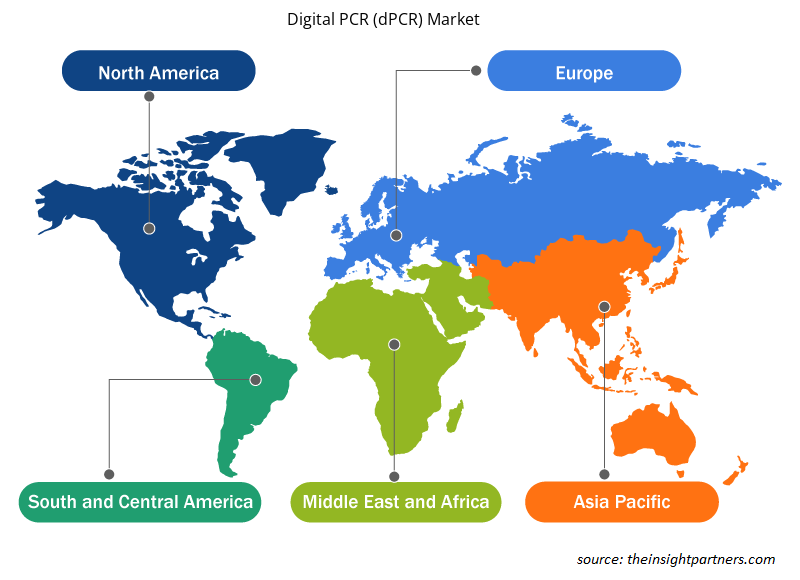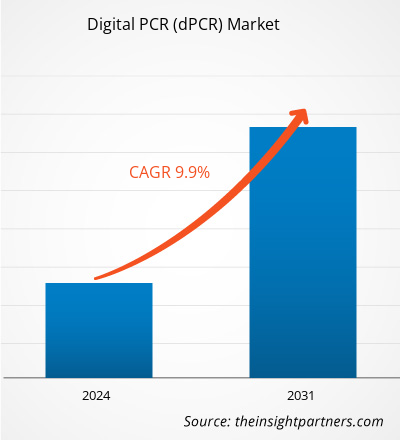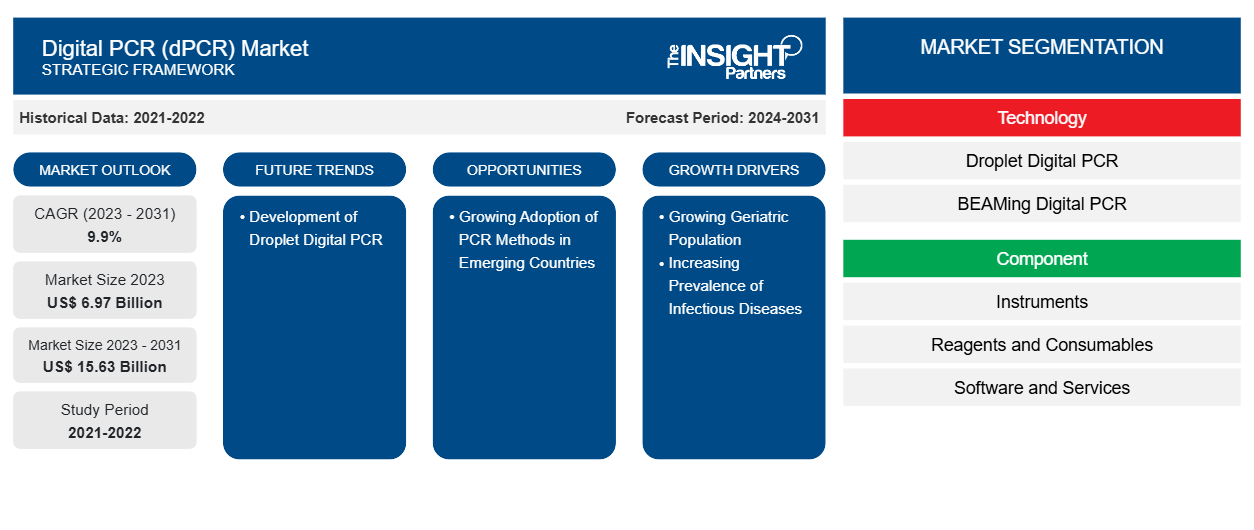Das Marktvolumen für digitale PCR (dPCR) soll von 6,97 Milliarden US-Dollar im Jahr 2023 auf 15,63 Milliarden US-Dollar im Jahr 2031 anwachsen; für den Zeitraum 2023–2031 wird eine durchschnittliche jährliche Wachstumsrate (CAGR) von 9,9 % erwartet.
dPCR ist eine bahnbrechende Technologie, die eine ultraempfindliche und absolute Nukleinsäurequantifizierung ermöglicht. Es ist eine der genauesten, präzisesten und empfindlichsten Techniken zum Nachweis spezifischer Nukleinsäuresequenzen. Es ist zu einem wichtigen und zuverlässigen Werkzeug für die molekulare Analyse geworden. Die zunehmende Häufigkeit genetischer und infektiöser Krankheiten, die mit dPCR-Techniken diagnostiziert und behandelt werden können, unterstützt das Wachstum des Marktes für digitale PCR (dPCR) . Zu den Markttrends für digitale PCR (dPCR) gehören technologische Fortschritte, die eine hochpräzise und absolute Quantifizierung von Ziel-DNA-Molekülen unterstützen und so ein breites Anwendungsspektrum in Diagnose und Forschung ermöglichen.
Wachstumstreiber:
Die Gensynthese ist das am weitesten verbreitete Werkzeug im Bereich der rekombinanten DNA-Technologie. Bei der Gensynthese werden rekombinante Proteinexpression und dPCR-Technologie sowohl zur Amplifikation als auch zur Quantifizierung eingesetzt. Im Jahr 2021 schloss Camena Bioscience, ein Startup für synthetische Biologie, das die Biotechnologie- und Pharmaindustrie mit Genen versorgt, eine von Mercia angeführte Finanzierungsrunde der Serie A in Höhe von 10 Millionen US-Dollar ab. Mit den zusätzlichen Mitteln plant das Unternehmen, seine Geschäftstätigkeit auszuweiten und seine Bemühungen zur Entwicklung von gSynth, seiner bahnbrechenden DNA-Syntheseplattform, voranzutreiben. Die Technologieplattform und andere damit verbundene Ressourcen helfen dem Unternehmen, die Entwicklung der Gensynthese zu beschleunigen.
Im Jahr 2020 gab EVONETIX LTD, ein Startup für synthetische Biologie, das eine Desktop-Plattform für hochpräzise, schnelle und skalierbare Gensynthese entwickelt, den Abschluss seiner Finanzierungsrunde der Serie B bekannt. Das von Foresite Capital (einem neuen Investor) geführte Unternehmen sammelte in dieser Runde 30 Millionen US-Dollar (23 Millionen Pfund) ein. Steigende Investitionen von Unternehmen treiben also das Wachstum des Marktes für Gensynthese an und tragen so zum Wachstum des Marktes für digitale PCR (dPCR) bei.
Passen Sie diesen Bericht Ihren Anforderungen an
Sie erhalten kostenlose Anpassungen an jedem Bericht, einschließlich Teilen dieses Berichts oder einer Analyse auf Länderebene, eines Excel-Datenpakets sowie tolle Angebote und Rabatte für Start-ups und Universitäten.
-
Holen Sie sich die wichtigsten Markttrends aus diesem Bericht.Dieses KOSTENLOSE Beispiel umfasst eine Datenanalyse von Markttrends bis hin zu Schätzungen und Prognosen.
Berichtssegmentierung und -umfang:
Die Marktanalyse für digitale PCR (dPCR) wurde unter Berücksichtigung der folgenden Segmente durchgeführt: Technologie, Komponente, Anwendung, Endbenutzer und Geografie. Basierend auf der Technologie ist der Markt in Droplet Digital PCR (ddPCR) und BEAMing Digital PCR segmentiert. In Bezug auf die Komponente ist der Markt in Instrumente, Reagenzien und Verbrauchsmaterialien sowie Software und Dienstleistungen unterteilt. Basierend auf der Anwendung ist der Markt in Klinik, Forschung und Forensik kategorisiert. Der geografische Umfang des Marktberichts für digitale PCR (dPCR) umfasst Nordamerika (USA, Kanada und Mexiko), Europa (Frankreich, Deutschland, Großbritannien, Spanien, Italien und Rest von Europa), Asien-Pazifik (China, Japan, Indien, Südkorea, Australien und Rest von Asien-Pazifik), den Nahen Osten und Afrika (Saudi-Arabien, Südafrika, Vereinigte Arabische Emirate und Rest von Nahem Osten und Afrika) sowie Süd- und Mittelamerika (Brasilien, Argentinien und Rest von Süd- und Mittelamerika).
Segmentanalyse:
Der Markt für digitale PCR (dPCR) wird nach Produkten in Droplet Digital PCR (ddPCR) und BEAMing Digital PCR unterteilt. Das ddPCR-Segment hatte 2023 einen bedeutenden Marktanteil. Es wird erwartet, dass es zwischen 2023 und 2031 die höchste CAGR auf dem Markt verzeichnet.
Basierend auf den Komponenten wird der Markt in Instrumente, Reagenzien und Verbrauchsmaterialien sowie Software und Serviceangaben unterteilt. Das Segment Reagenzien und Verbrauchsmaterialien hatte 2023 einen bedeutenden Marktanteil und wird voraussichtlich zwischen 2023 und 2031 die höchste durchschnittliche jährliche Wachstumsrate verzeichnen.
Basierend auf der Anwendung ist der Markt in Klinik, Forschung und Forensik segmentiert. Das klinische Segment hielt 2023 einen bedeutenden Marktanteil bei der digitalen PCR (dPCR); es wird erwartet, dass es zwischen 2023 und 2031 die höchste durchschnittliche jährliche Wachstumsrate verzeichnet.
Basierend auf dem Endverbraucher ist der Markt in Krankenhäuser und Diagnosezentren, Pharma- und Biotechunternehmen, Forschungslabore und akademische Institute, forensische Labore und klinische Forschungsorganisationen segmentiert. Das Segment Krankenhäuser und Diagnosezentren hielt im Jahr 2023 einen bedeutenden Marktanteil bei der digitalen PCR (dPCR); es wird erwartet, dass es zwischen 2023 und 2031 die höchste durchschnittliche jährliche Wachstumsrate verzeichnet.
Regionale Analyse:
Geografisch ist der Markt für digitale PCR (dPCR) in Nordamerika, Europa, Asien-Pazifik, Süd- und Mittelamerika sowie den Nahen Osten und Afrika unterteilt. Im Jahr 2023 eroberte Nordamerika einen bedeutenden Marktanteil. Im Jahr 2023 dominierten die USA den Markt in dieser Region. Das Wachstum des Marktes für digitale PCR (dPCR) in Nordamerika ist auf wissenschaftliche Konferenzen, Workshops und Veranstaltungen in den USA und Kanada zurückzuführen, die Teilnehmern aus verschiedenen Teilen der Welt helfen, Trends und die neuesten Forschungsergebnisse auf der Grundlage von PCR auszutauschen. So veranstaltete Global Engage von Global Information Incorporation beispielsweise einen zweitägigen Gipfel, bei dem der Beitrag von Wissenschaftlern aus aller Welt zu dPCR-Strategien und -Entwicklungen vorgestellt und Fallstudien diskutiert wurden, die den Beitrag von dPCR im Gesundheitswesen beinhalten. Das aktive Engagement des Landes ist auch einer der treibenden Faktoren, die zum Wachstum der Region auf dem globalen Markt für digitale PCR (dPCR) in der Region führen.
Branchenentwicklungen und zukünftige Chancen:
Der Marktbericht zur digitalen PCR (dPCR) umfasst die Positionierung und Konzentration des Unternehmens, um die Leistung der Wettbewerber auf dem Markt zu bewerten. Laut Pressemitteilungen des Unternehmens sind im Folgenden einige Initiativen der wichtigsten Akteure auf dem Markt aufgeführt:
- Im Juli 2023 brachte Bio-Rad Laboratories, Inc. seinen ersten ultrasensitiven Multiplex-dPCR-Test auf den Markt – das ddPLEX ESR1 Mutation Detection Kit. Mit der Markteinführung dieses Produkts plant das Unternehmen, die Verfügbarkeit seines ddPCR-Angebots für den Onkologiemarkt zu erweitern, wo hochsensitive und Multiplex-Mutationserkennungstests die translationale Forschung, die Therapieauswahl und die Krankheitsüberwachung unterstützen.
- Im Juni 2021 stellte Bio-Rad Laboratories Inc. das „Prevalence ddPCR SARS-CoV-2 Wastewater Quantification Kit“ vor, ein empfindliches, kostengünstiges und genaues Instrument zum Nachweis von SARS-CoV-2 im kommunalen Abwasser.
- Die Centers for Disease Control and Prevention (CDC) empfehlen ddPCR-Techniken zur Untersuchung von Abwasser und die Environmental Protection Agency (EPA) hat die Technologie als zuverlässige Methode zur Quantifizierung von Viren im Abwasser veröffentlicht.
Regionale Einblicke in den Markt für digitale PCR (dPCR)
Die regionalen Trends und Faktoren, die den Markt für digitale PCR (dPCR) während des gesamten Prognosezeitraums beeinflussen, wurden von den Analysten von Insight Partners ausführlich erläutert. In diesem Abschnitt werden auch die Marktsegmente und die Geografie für digitale PCR (dPCR) in Nordamerika, Europa, im asiatisch-pazifischen Raum, im Nahen Osten und Afrika sowie in Süd- und Mittelamerika erörtert.

- Erhalten Sie regionale Daten zum Markt für digitale PCR (dPCR)
Umfang des Marktberichts zur digitalen PCR (dPCR)
| Berichtsattribut | Details |
|---|---|
| Marktgröße im Jahr 2023 | 6,97 Milliarden US-Dollar |
| Marktgröße bis 2031 | 15,63 Milliarden US-Dollar |
| Globale CAGR (2023 - 2031) | 9,9 % |
| Historische Daten | 2021-2022 |
| Prognosezeitraum | 2024–2031 |
| Abgedeckte Segmente |
Nach Technologie
|
| Abgedeckte Regionen und Länder |
Nordamerika
|
| Marktführer und wichtige Unternehmensprofile |
|
Marktteilnehmerdichte für digitale PCR (dPCR): Auswirkungen auf die Geschäftsdynamik verstehen
Der Markt für digitale PCR (dPCR) wächst rasant, angetrieben durch die steigende Nachfrage der Endnutzer aufgrund von Faktoren wie sich entwickelnden Verbraucherpräferenzen, technologischen Fortschritten und einem größeren Bewusstsein für die Vorteile des Produkts. Mit steigender Nachfrage erweitern Unternehmen ihr Angebot, entwickeln Innovationen, um die Bedürfnisse der Verbraucher zu erfüllen, und nutzen neue Trends, was das Marktwachstum weiter ankurbelt.
Die Marktteilnehmerdichte bezieht sich auf die Verteilung der Firmen oder Unternehmen, die in einem bestimmten Markt oder einer bestimmten Branche tätig sind. Sie gibt an, wie viele Wettbewerber (Marktteilnehmer) in einem bestimmten Marktraum im Verhältnis zu seiner Größe oder seinem gesamten Marktwert präsent sind.
Die wichtigsten Unternehmen auf dem Markt für digitale PCR (dPCR) sind:
- Thermo Fisher Scientific, Inc.
- F. Hoffmann-la Roche Ltd.
- QIAGEN
- Akara Bio, Inc.
- Agilent Technologies, Inc.
Haftungsausschluss : Die oben aufgeführten Unternehmen sind nicht in einer bestimmten Reihenfolge aufgeführt.

- Überblick über die wichtigsten Akteure auf dem Markt für digitale PCR (dPCR)
Wettbewerbslandschaft und Schlüsselunternehmen:
Die Marktprognose für digitale PCR (dPCR) kann Stakeholdern bei der Planung ihrer Wachstumsstrategien helfen. Thermo Fisher Scientific, Inc.; F. Hoffmann-la Roche Ltd.; QIAGEN; Akara bio, Inc.; Agilent Technologies, Inc.; Biomerieux SA; Abbott Laboratories; Merck KgaA; Promega Corporation; und BD gehören zu den führenden Akteuren auf dem Markt. Diese Unternehmen konzentrieren sich auf die Einführung neuer Hightech-Produkte, die Weiterentwicklung bestehender Produkte und die geografische Expansion, um die weltweit wachsende Verbrauchernachfrage zu erfüllen.
- Historische Analyse (2 Jahre), Basisjahr, Prognose (7 Jahre) mit CAGR
- PEST- und SWOT-Analyse
- Marktgröße Wert/Volumen – Global, Regional, Land
- Branchen- und Wettbewerbslandschaft
- Excel-Datensatz
Aktuelle Berichte
Erfahrungsberichte
Grund zum Kauf
- Fundierte Entscheidungsfindung
- Marktdynamik verstehen
- Wettbewerbsanalyse
- Kundeneinblicke
- Marktprognosen
- Risikominimierung
- Strategische Planung
- Investitionsbegründung
- Identifizierung neuer Märkte
- Verbesserung von Marketingstrategien
- Steigerung der Betriebseffizienz
- Anpassung an regulatorische Trends























 Kostenlose Probe anfordern für - Markt für digitale PCR (dPCR)
Kostenlose Probe anfordern für - Markt für digitale PCR (dPCR)